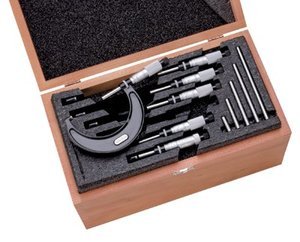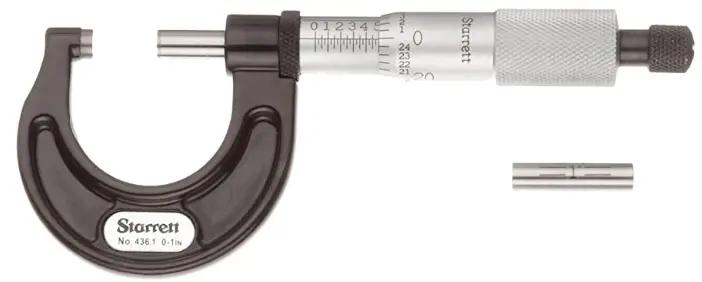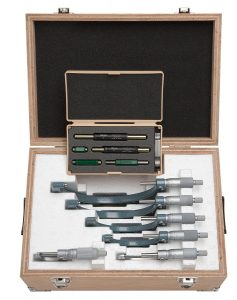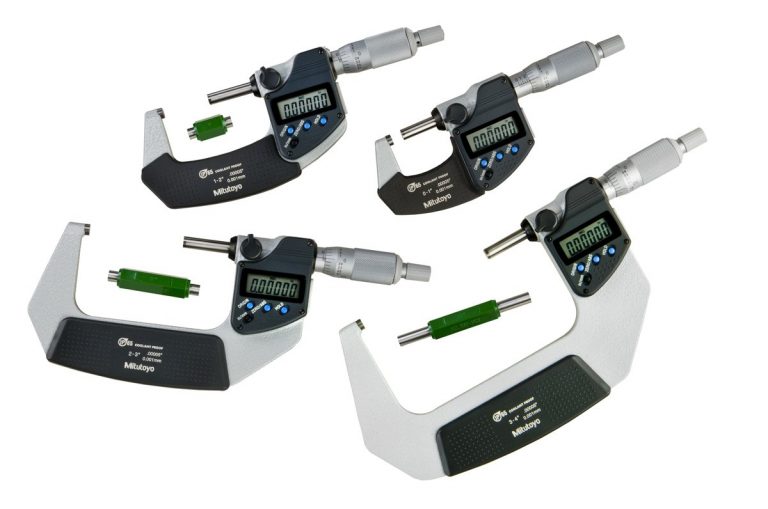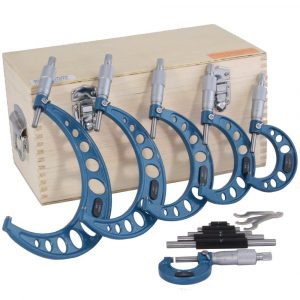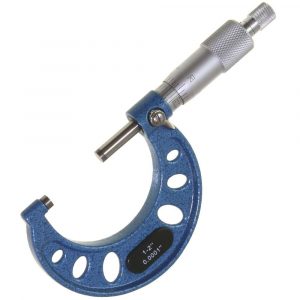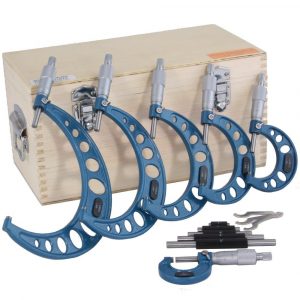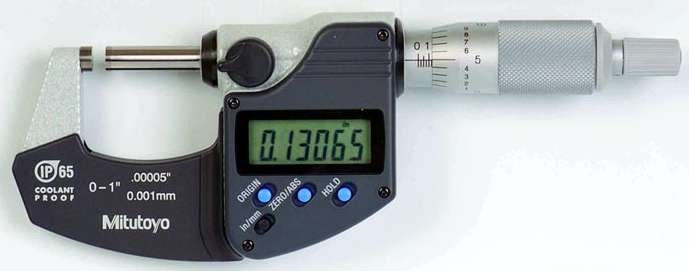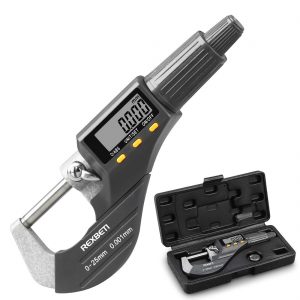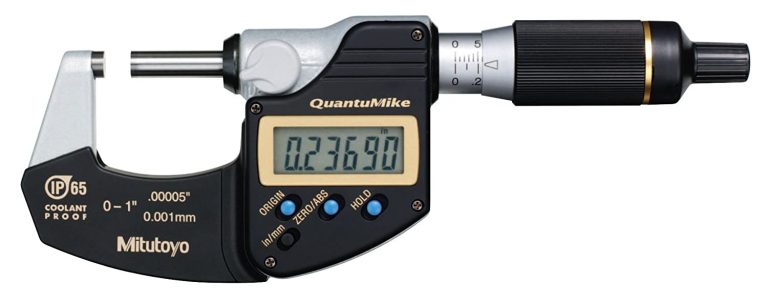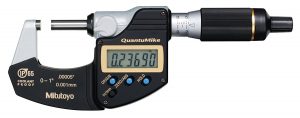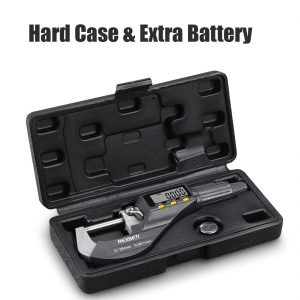Check out our comprehensive digital micrometer buyers guide which includes tips for finding the right tool for you as well as everything to consider when comparing digital micrometers.
digital micrometers
Ultimate Guide to Digital Micrometers
Digital micrometers are one of the most accurate measurement devices available for precisely measuring parts of all sizes.
Machinists and hobbyists around the world use them in their everyday work. A good 0-1″ micrometer is likely the only precision measuring tool that can compare in use to a set of digital or dial calipers.
Because they get so much use, it is important to make sure you get a quality set of micrometers and more importantly, that you know how to use them to achieve the accuracy they are capable of.
Check out our guides and tips below to further your understanding of digital micrometers.
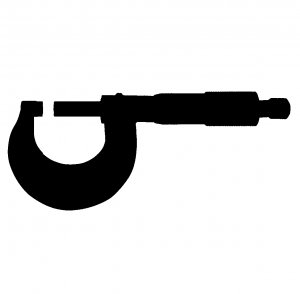
A Beginner's Guide to Micrometers
Everything you need to know to get started with digital micrometers. Includes all of the frequently asked questions that come up when working with digital micrometers.

Digital Micrometer Buyers Guide
Find out which digital calipers top our best of list. Includes an extensive list of things to consider when purchasing a digital micrometer.

Digital Micrometer Info Guides
Explore our selection of informational guides to expand your knowledge of digital micrometers.

Digital Micrometer Reviews
Check out the latest digital micrometer reviews from well-known brands such as Mitutoyo, Starrett, Anytime Tools, and many more.
Recommended articles
For more information check out these related articles:
Best Micrometer Sets for Machinists and Hobbyists
Not many tools get as much inspection use as a micrometer. As a result, the first inspection tool purchased by many is a good micrometer or a micrometer set.
Because of their expense, they are not tools that you will want to buy more than once. The good thing is that if chosen carefully, they will last a lifetime or more. As the saying goes, “buy once, cry once”.
Now take a look at the best micrometer sets available, many of which have been best in class for many, many years.
Best micrometer set
Starrett ST436.1CXRLZ 0-6" Outside Micrometer Set
When it comes to the standard analog micrometers, nobody makes them like Starrett. The most important aspect of a micrometer is its accuracy and these mics by Starrett are extremely accurate and repeatable.
As long as you exercise due care in your measurements, you can expect them to be accurate to .0001”. While it is true that many other manufacturers have been able to create a tool that is capable of the same accuracy, few come close to the build quality of a Starrett micrometer.
It can be hard to quantify the “feel” of a tool. In this case, these mics just feel right. The weight is nice without being too heavy. More importantly, they have a nice balance to them that never seems to get in the way of your measurement.
The finish of both the frame of the micrometer as well as the sleeve has always been excellent. The knurling on the thimble and ratchet provides the perfect amount of grip.
Speaking of the ratchet, I have always found that Starrett makes the best ratchets. Ratchet preferences can vary from person to person but the thing that is nice about these ratchets is they are extremely consistent. Between mics in a set, the ratchets will all feel the same.
Starrett has been making these same micrometers for quite some time and largely without change. If it ain’t broke, don’t fix it.
The one downfall of these micrometers is that the quality does come with a price. For this reason, I have included a second choice in the Mitutoyo set below. It can also be worth considering the best digital micrometer set if you need more accuracy and can live with a smaller measuring range.
Used versions of these tools can be an excellent choice also because all of the choices noted here, from both Starrett and Mitutoyo, have a long history of being quality measuring tools. They have been mostly unchanged through the past couple decades.
As a side note, the case that comes as part of the set is as well made as the micrometers themselves.
This set of micrometers form Mitutoyo checks all the boxes. They are accurate, consistently well-made and reliable. They are only a small step below the set by Starrett. While they might not be the absolute best micrometer set available, they might be the best value because the price is substantially lower than that of the Starrett set.
For comparisons sake, if the micrometer set from Starrett is a Rolls Royce, then the set by Mitutoyo is a Cadillac. This is certainly reflected in the price difference.
The main difference between the sets is in the feel of the mics. The finish of the Mitutoyo set is nice, but not on the same level as that of the Starrett set. Also, I have always found the ratchet mechanism and balance of the mics by Mitutoyo to be very good but not as great as the Starretts.
I feel like this might sound like the Mitutoyo set is not that great but in reality, they are excellent. They just aren’t quite as good as the Starretts. However, they are much better than all the other micrometers out there and they come with a much smaller price tag.
Best digital micrometer set
Mitutoyo 293-961-30 Digimatic Micrometer 0-4”
I absolutely love the Mitutoyo Digimatic micrometers. They are easily the most accurate normal micrometers out there. Sure, you can find specialty mics with indicators built in that will be more accurate, but they will be more expensive and less user friendly.
If given the choice, I would use Mitutoyo Digimatic mics for all micrometer measurements. They are quick to read and extremely accurate.
The only knock I could give them is that some might find them a little bulky. Personally, I have never found this to be the case, but they are larger than your average analog mic.
Digital micrometers also make a great choice when working in both inch and metric units. The ease with which they switch measuring units saves time and eliminates any potential conversion miscalculations that might occur by the user.
Another great feature of the Digimatic mics that is not common among other digital micrometers is that the batteries seemingly last forever. No, not literally but even with heavy use it feels like it.
The sole reason they didn’t make the best overall micrometer set is that the set includes less micrometers and is limited to measuring sizes up to 4”. If this isn’t a problem for your applications then think about taking a good, hard look at the Mitutoyo Digimatic mic set. They are an absolute top of the line set.
Best budget micrometer set
Anytime Tools 0-6” Outside Micrometer Set
In recent years, some of the Chinese made micrometer manufacturers have greatly increased their quality. Anytime Tools is a prime example of this. They have been able to create tools for a fraction of the price of a traditional micrometer while largely maintaining the accuracy and quality seen with more well-known manufacturers.
The improvement in Chinese made micrometers is so great that some American tool manufacturers have been outsourcing their tools to other countries.
With regards to accuracy, they claim to be accurate to .0001” as you would expect from a good micrometer. In practice, they aren’t quite there all the time. It would be safe to count on .0002” accuracy. If you are looking for more than that then make sure to verify the accuracy when you receive them.
The Anytime Tools set comes with all the standard micrometer set accessories including reference standards for verifying their accuracy and a wooden case. The case isn’t as nice as what comes with more expensive sets, but it is just a box after all. It holds all of the included mics and closes to keep out the elements. It makes a perfectly acceptable storage solution.
The feel of this set isn’t quite as nice as those from Mitutoyo and Starrett but the reduction in price can not be overlooked. This set could be purchased along with a set of gage blocks to verify their accuracy and the price tag would still be well under the cost of other quality sets.
I would never recommend going cheap when it comes to your precision measuring tools if they are critical to your job. The one exception is, if you are a hobbyist or just entering the machining trade, this micrometer set from Anytime Tools makes a great starter set that just might meet all of your current and possibly future measurement needs.
Things to consider when purchasing a micrometer set
How big of a set to get
It all comes down to the sizes you plan to measure. Usually, the required measurements are skewed towards the lower end of the measuring scale. A 0-1” micrometer will be the size used most often. The 1-2” micrometer will be the 2nd most used micrometer and so on.
As the sizes get larger, they will see substantially less usage. Even in a high use environment such as a machine shop, a 5-6” micrometer or 11-12” micrometer will rarely be used.
My recommendation would be to not buy a larger set than you need. A good micrometer set is not cheap and therefore you should ensure the tools will get used. You don’t want a box full of expensive paperweights.
Unless you know that you absolutely need it, I would never recommend purchasing a set larger than 12”. A 0-6” set makes a good starting point for most people and if you think you can get away with something slightly smaller then go for it.
It is better to buy a higher quality 0-3” set than it would be to have a 0-6” set where the 4-6” mics never get used.
Accuracy
Accuracy and repeatability are the most important qualities in a micrometer. It is possible to find a wide variety of accuracies available in micrometer, especially when it comes to older used tools.
You should look to get a micrometer with an accuracy of .0001” or better. I have included a cheaper, slightly less accurate budget set above, but you should only go with that set if price is your primary concern and you know that the reduction in accuracy is acceptable for your measurements.
I have never known anyone to regret purchasing a more accurate tool.
Analog vs mechanical counter vs digital
Each type of micrometer has its pros and cons.
Analog mics are always ready to go. You never need to worry about dead batteries and aren’t quite as susceptible to contamination (coolant, etc.) when compared to digital micrometers.
Digital micrometers are easier to read, quicker to take measurements and allow the user to easily switch between measurement units. Additionally, they allow the user to switch their zero location at will. There are many instances were comparison measurements need to be taken. Digital micrometers allow these types of measurement to be taken quickly without the added need for manual calculations.
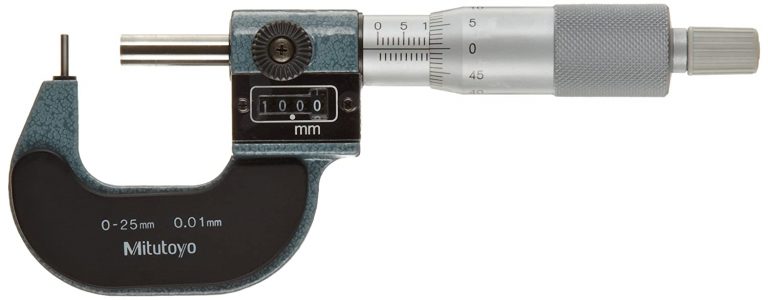

I do not recommend the mechanical counter micrometers. They add another mechanism that can malfunction simply don’t provide enough of an added benefit to justify their use. Electronic digital micrometers can be found for the same price as the mechanical counter versions.
Go with a standard analog micrometer or a solid digital version and skip the prone mechanical counter varieties.
Cases
Cases are all about protection. You don’t need anything too fancy when it comes to cases. The standard wooden case that comes with most micrometer sets is more than capable of storing your tools.
The case gives the tools a place to stay with protection from the elements (there can be a lot in the air when machining) and also a safe storage option. Too often a micrometer left on a workbench gets bumped and ends up hitting the floor.
Keep your tools safe and make sure to put them away when not in use so they remain accurate for years to come.
Carbide vs steel tips
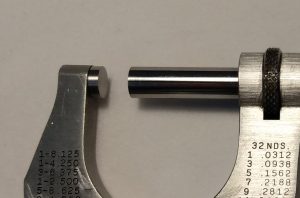

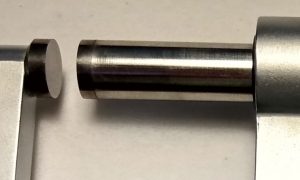

Carbide tipped micrometers provide increased wear resistance. In general, I have not found them to provide an added benefit to hardened steel.
Please note that carbide can be more brittle as a result of the added toughness which means they are susceptible to chipped measuring faces. If cared for properly, this will likely not be an issue, but it is something to keep in mind.
The main case for carbide tips would be when dealing with particularly abrasive materials.
For most users, both carbide and steel tipped micrometers will be more than adequate.
Calibrated or not
There are manufacturers and sellers out there who offer calibrated micrometers for an added cost. This is not an item that is worth paying extra for.
The micrometers should be made accurate from the start. Calibration only gets you documented evidence that your tool is verified as accurate using a reference standard that is traceable to NIST. If this is something you require then you likely already have a set of calibrated gage blocks that will allow you to do the calibration on your own.
Shipping companies are not always gentle with your packages so keep in mind that it would be entirely possible to pay extra for calibration and have the calibration voided by shock from shipping.
Skip the calibration upcharge and verify your micrometers on your own.
Summary
Choosing a micrometer set is not an easy decision. Even the cheapest options cost a pretty penny. The most important things to consider is the accuracy you need as well the size of the set you require.
If they will be used daily, don’t be afraid to splurge and pick up a heirloom quality set from Starrett or Mitutoyo. They really are worth it and built to last.
Related articles
For more information check out these related articles:
Best Micrometer Brands – New, Used and Everything In Between
Micrometers are incredibly accurate measuring tools. They get used for the most demanding measurements from engine work to reloading. Measurements that critical require tools that will ensure your project is done right.
When it comes to micrometers, the best manufacturers are the ones that consistently put out a quality product. These are those brands:
Best micrometer brand
Starrett
Starrett has been in the micrometer business for a very long time. It’s no surprise that they are capable of creating quality measuring tools at such a consistent pace. They nearly perfected the micrometer and have maintained that excellence throughout the years. Starrett is a good brand to look into when buying a standard micrometer.
You are very unlikely to come across a Starrett micrometer that doesn’t measure accurately without being subjected to a substantial amount of abuse. Their digital micrometers face some stiff competition that keeps them from being the top dog but their standard analog mics are the best of the best.
Best budget micrometer brand
Anytime Tools
Anytime Tools is new to the game. Started in 1999, they have really come on strong. 20+ years in the industry might sound like a long time but and when it comes to measuring tools many of the players in the game have been around for decades not years. Starrett and Mitutoyo have each been making gauges for over 100 years.
Much cheaper than other micrometer manufacturers such as Starrett, Mitutoyo or Fowler, Anytime Tools is an American company but I am fairly certain they source their products from another country. The good thing is that it seems to have no effect on their quality. They are consistently producing tools comparable to other big name manufacturers and at a fraction of the price.
As a side note, Anytime Tools also owns iGaging which has also been producing consistent quality measuring instruments.
Best digital micrometer
Mitutoyo
Mitutoyo is hands down the best digital micrometer manufacturer. Their Digimatic line of digital micrometers blows the competition away. They come at a premium cost, but the price is worth it. Mitutoyo digital mics are the standard by which all other micrometers should be judged.
The build quality and accuracy of Mitutoyo’s Digimatic micrometers is second to none. They are precise, accurate and hold up very well to all types of abuse they might encounter in a normal machine shop environment.
If you really want the best, consider their QuantuMike. Read our review to understand why.
Best budget digital micrometer brand
Rexbeti
Rexbeti is a newer competitor in the digital micrometer space. What they lack in experience they certainly make up for in quality.
While they can’t quite compete with the likes of Mitutoyo and their Digimatic micrometers, they do come pretty darn close at a fraction of the price. For most users, the .0001” accuracy of the Rexbeti digital micrometers will be more than sufficient.
One concern with just about all of the cheaper digital micrometers is that the battery life is much shorter than higher end models. Not a deal breaker but think about keeping some spares on hand so you know the tool is ready to go when you need it.
Also, if you won’t be using the micrometer frequently then think about taking out the battery between uses to save on battery life.
Best used analog micrometer brand
Starrett
We already covered Starrett’s long track record of producing excellent micrometers above. Just a reminder that this is a very good thing for anyone shopping for a quality used mic as well.
Very little has changed over the years with their standard micrometer line. There have been small variations in the frames and other components but nothing earth shattering. The most important aspect of their micrometers hasn’t changed. The accuracy has consistently been excellent.
While it would be great to purchase a brand-new micrometer and care for it lovingly from day one, sometimes you just want to save a little cash. The good news is that as long as you verify the accuracy of the tool, there is very little reason to expect that a used micrometer would perform any differently than a new one.
In fact, a huge portion of Starrett micrometers made decades ago are still measuring good as new. They aren’t the only ones either just one of the most consistent. For some more used micrometer recommendations see other brands to consider section below.
Best used digital micrometer brand
Mitutoyo
Digital micrometers are different from your standard analog micrometers. They have changed substantially over the years.
The earliest digital micrometers were not nearly as reliable. If you are looking for a used digital micrometer, stick with something from Mitutoyo’s Digimatic line. They have been exceptional for many years.
There have been other good digital micrometers over the years from various manufacturers, but the quality has been kind of up and down. Some had battery life issues. Others are not nearly as accurate as you would hope. Battery life is easily remedied by keeping a spare in your toolbox. They are cheap enough nowadays.
When it comes to any micrometer, analog or digital, accuracy is the most important factor.
At the risk of sounding like a broken record, check the accuracy of any used tools before purchasing.
Please note there are also an assortment of mechanical digital micrometers on the market. Some people like them. I have never been that person. Their greatest positive is that they don’t require batteries. Unfortunately, all of the mechanical digital micrometers I have used were not precise enough for my taste. They are not something that I recommend but mechanical digital micrometers are an interesting tools nonetheless.
Other brands to consider
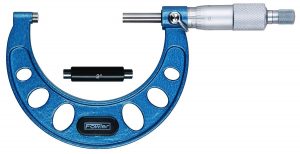

While we have listed the absolute cream of their crop in their respective categories, there are many other brands to consider.
The hard part is that unfortunately many brands which were known for their quality in years past have moved manufacturing to new locations and quality has suffered as a result.
This can make it difficult to know whether their tools are quality or trash because they simply aren’t consistent.
I recommend the following brands for both new and used tools. Still make sure to verify their accuracy whether buying new or used. You never know how the previous owner or the UPS man treated them.
- Fowler
- Brown and Sharpe
- Etalon
Things to consider when buying a micrometer new or used
Check the specified accuracy
Most micrometers should be accurate to .0001”. Some of the best such as the Mitutoyo digital mics listed above are good to .00005”. That’s twice as good and going to be overkill for most users.
One thing to watch out for is that some older micrometers are only accurate to .001”. If you only need accuracy of .001” then go with a caliper instead. They provide more versatility in your measurements. You should be buying a micrometer for extreme accuracy. Avoid mics that are only accurate to .001”
Check the accuracy yourself
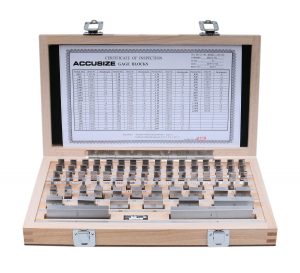

Micrometers are precision measuring tools. Because their accuracy is so important, it is essential that its accuracy is verified before purchasing if used or immediately after receiving the tool if new.
Take a known standard such as a set of calibrated gauge blocks and check the tool at various steps across its measuring range.
For example, if you have a 0-1” micrometer, try to check it at 0.000”, .250”, .500”, .750” and 1.000”. Sometimes this might not be possible but it is good practice to check at random intervals. Many times, users will only check the tool at the two ends of the measuring ranges, in this case 0.000” and 1.000”. In most cases, this is sufficient but if you can check intervals in between it will be a better verification of the accuracy.
How to care for your micrometer
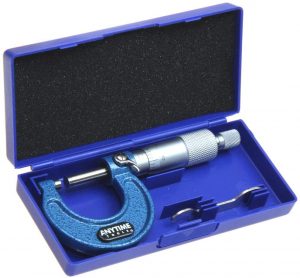

Look for a micrometer with a case. For used tools, this is a great indicator that the tool was well cared for. A case doesn’t need to be anything fancy.
I have seen used tools with purple velvet lined cases. They were actually the worst. The velvet, felt or whatever the material was gets dirty with oil and coolant eventually. A simple, easy to clean plastic case is the best type to have.
If you keep your micrometer in a case or toolbox, you will be handling 95% of the care needed. You would think that a tool as precise as a micrometer would be a delicate instrument. In reality, they are quite rugged.
Keep your mic clean and out of harms way and it will measure accurately for many years to come.
Do I need a calibration or NIST traceable certificate?
No, a calibration certificate is not needed. You need to verify the accuracy yourself and should make sure to do it regularly.
The best practice is to check the accuracy every time you use the micrometer. You should always assume that the janitor at your shop or your kids in your garage have knocked the tool on the floor and put it back in its place hoping no one will be any wiser.
A calibration certificate only certifies that the tool was accurate somewhere else. It doesn’t do you any good in your shop.
Tips for finding a quality used micrometer
Don’t be afraid to explore Craigslist or Facebook for cheap micrometers. Yard sales and estate sales are another good option for budget tools.
In most cases, people will price them one of two ways. Either same as brand new or dirt cheap.
Do not buy used at like new prices. If it isn’t a quarter or a third of the new price then avoid the deal. You would be better off spending a little more and knowing the history of the tool.
If you can find a good cheap used micrometer there is no reason to believe it won’t last for years to come.
If there are any tips we forgot please let us know and share them in the comments below.
Related articles
For more information check out these related articles:
Mitutoyo QuantuMike Review
Summary
Straight to the point. The Mitutoyo QuantuMike digital micrometer is an excellent inspection tool. It does everything an ordinary micrometer does but four times faster. Simply put, this is a top of the line measuring tool but the quality comes at a price.
Let’s get into the features.
Features
The QuantuMike has a big easy to read LCD display. It reads measurements in both inches and millimeters. Inch and metric values are switched at the press of a button.
Speaking of buttons…
The buttons on this micrometer and frankly all of the Mitutoyo Digimatic micrometers I have used, pull off something that seems very simple but in practice isn’t. The buttons are both easy to use and hard to press on accident. What this means is that your measurements are never lost because you accidentally hit the origin button. It can be hard to describe how the feel of a tool plays into its quality. In this case the QuantuMike just feels good.
Build quality
The build of the QuantuMike digital micrometer is excellent. None of the plastic and metal components of the mic seem cheap or flimsy. It’s solid. One potential negative is that some may find the weight of tool a little on the heavy side. I have never found this to be the case but all of Mitutoyo’s Digimatic micrometers are balanced differently than a normal, non-digital micrometer which might feel strange to some. It may take a little getting used to but once it clicks, you won’t want to go back to a standard mic.
Battery
Battery life for the QuantuMike is listed at 2.4 years. That seems a little long to me, but in practice the standard SR44 battery lasts long enough that I don’t think about it and just try to keep an extra battery on hand. This has been my experience with what I would call a medium amount of use in your standard machine shop. If you are going to use it in your garage sporadically, then I would venture to guess the battery will die of old age before being drained.
Protection from the elements
The QuantuMike has an IP rating of IP65. IP stands for ingress protection and the two numbers tell you how well protected from solids and liquids the instrument is. Protection from dust and coolant is what you should look for in an IP rating.
The first digit, 6 in this case, is for solids protection and the QuantuMike is completely protected from dust. This is the highest level of solids protection on the IP rating scale.
The second digit, 5 for the QuantuMike, is for liquids protection. The QuantuMike is protected from water jets from any direction.
The video below shows what level of protection this provides. I would not recommend recreating the test at home with something as nice as this digital mic. Practically, it means your tool will be safe from splashing coolant. However, you should still do your best to keep it clean and dry.
Speaking of clean and dry, the provided plastic case will help you keep it that way. The QuantuMike comes with a fairly standard plastic case but it gets the job done. I should also note that while not all micrometers come with a case, I would certainly expect one for a tool in this price range.
Accuracy


Let’s face it, accuracy is by far one of the most important qualities of a micrometer. It’s a measuring tool so it isn’t worth much if it won’t measure with accuracy and precision. Luckily the QuantuMike is extremely accurate. Boasting .00005”/.001mm accuracy, this micrometer is highly accurate and precise. Measurements repeat very well.
Speed
The standout speed of the QuantuMike is what sets it apart from other digital micrometers. Each revolution of the thimble moves the anvil in or out .080” or 2mm.
That is four times faster than a standard micrometer. Not the type of feature that matters to a hobbyist even though it is convenient, but for someone checking hundreds or possibly thousands of parts per day it can mean a huge amount of time saved.
Most machinists will use a 6” caliper or a 0-1” micrometer more than any other measurement device. It’s a good idea to have a quality set for these highly used tools.
Other features
- Carbide tips
- Thimble ratchet for consistent measurements
- Measurement lock
- Some versions have SPC output
- 1 year warranty, 3 if registered with Mitutoyo
Verdict
The Mitutoyo QuantuMike digital micrometer is an excellent piece of measuring equipment. The precision and accuracy are top knotch. Battery life is looooooooooong and the speed of measurement is second to none. If you can afford it, you won’t regret it.
What to consider when buying a digital micrometer
Value
The price and the quality affect the overall value of a micrometer. The tricky part is that they really only come in two types, cheap and expensive. There isn’t much middle ground. The hard part is that price does not equal quality. Brands vary wildly in terms of quality. Mitutoyo is one of, if not the best micrometer manufacturer and their quality is in line with their prices. Expensive but worth it to the right user.
Accuracy
Anyone who wants or uses a micrometer needs an accurate measurement. The question is how accurate? Experienced users know the tolerances they need when it comes to a measuring tool. This micrometer measures to 0.00005” or .001mm and that is likely overkill for most people unless they work in a machine shop.
Many might not even know amount of accuracy they need. If this is the case, you would likely be perfectly fine going with a digital caliper. Like micrometers, calipers have a big range of prices. The difference is that calipers are quite a bit cheaper on the average than micrometers.
If you are just getting started when it comes to measurement, think about Mitutoyo calipers if your budget allows or this VINCA caliper. Mitutoyo is pretty consistent with their quality across most of their measuring tools but the VINCA caliper comes pretty close at a much cheaper price.
Absolute or incremental mode
Measurements can be taken in two forms. Absolute values or incremental values. Not all digital micrometers have incremental mode.
Absolute gives you a measurement from a zero point. For a 1-2” micrometer, the zero point would be 1”.
Incremental measures from a specific standard. Using the same 1-2” micrometer in incremental mode would allow the zero to be set at something other than 1”. The display would then read the deviation from the standard you are using such a set of gage blocks.
IP rating
Micrometers are usually rated at one of three IP ratings.
No rating which means there is no protection. Be especially careful around coolant.
IP54 means dust can get into the tool but it won’t affect it and that splashing water is fine. This is usually enough for most use cases.
IP65 is protected from dust and any amount of water that it would normally be exposed to. Anything over this is overkill.


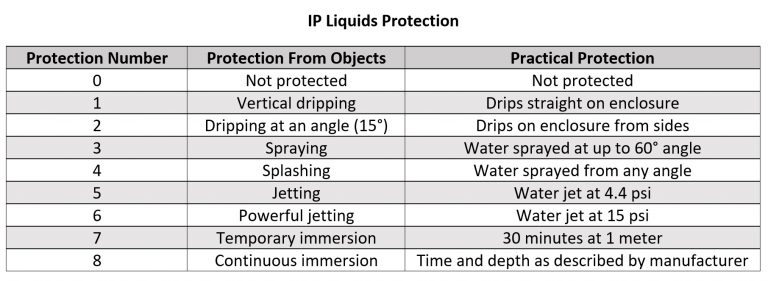

Data ouput
An SPC output lets you send measurements to a printer or computer. Most won’t need this feature, but it could come in handy in a high volume machine shop.
Related articles
For more information check out these related articles:
Rexbeti 0-1″ Digital Micrometer Review




Pros
Cheap price
Accuracy




Cons
Few extra features
Features
Rexbeti isn’t exactly a household name when it comes to inspection tools such as this 0-1” digital micrometer. What it lacks in name recognition, it makes up for in price but the question is can the quality keep up?
The Rexbeti 0-1” digital micrometer has a .00005” or .001mm resolution which is standard for most digital micrometers. It has an accuracy of +/- .0001” which is only slightly worse than some of the best digital mics such as this one from Mitutoyo but better than most budget options. Prices fluctuate some but the Rexbeti sacrifices very little in accuracy while cutting the cost dramatically.
The digital readout on this set of micrometers is large and easy to read. The display has a simple button layout with only 3 buttons on the face. These primary buttons are on/off, one for switching units between inches and millimeters, and one for zeroing the tool.
The Rexbeti 0-1” digital micrometer features a ratchet stop for taking consistent measurements. The ratchet stop when used correctly allows the user to exert a controlled amount of force when taking readings. This results in more accurate and consistent measurements. Additionally, when not in use this digital mic has an auto shut off feature to save battery life. The tool also comes with an extra battery and a protective case for storage.
Verdict
Beyond these simple features this Rexbeti micrometer doesn’t have anything too fancy going on. What it lacks in extras though, it makes up for in accuracy. When compared to many other budget digital micrometers, its accuracy stands out for the price. These Rexbeti 0-1” digital micrometers are a great buy at the price and capable of measuring up to all but the most precise digital micrometers.
Related articles
For more information on micrometers see these related articles:
iGaging 0-1″ Digital Micrometer Review
Features
iGaging is a popular brand for budget friendly inspection tools. This set of digital micrometers is no different. They have a measuring resolution of .00005” or .001mm and an accuracy of +/- .00015” which equates to +/- .003mm. While not as good as some digital micrometers which cost 2-3 times as much, the iGaging digital mics come close at a fraction of the price.
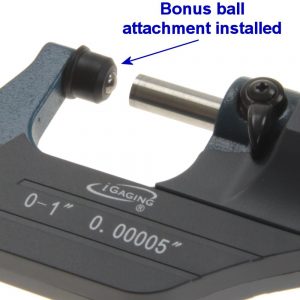

These iGaging digital micrometers have a very impressive feature set. Some of the extras that aren’t normally seen in its price range are a SPC output and a ball attachment for the anvil. The SPC output allows you to record measurements directly to your computer while the ball attachment allows you to measure round surfaces such as the wall thickness of tubing. Some of the more standard type features include an extra battery and a protective case to keep your tool safe. Carbide tips are a nice bonus that isn’t always seen on budget level digital micrometers. They provide superior wear resistance when compared to normal hardened steel.
A decent size display and simple button layout adorn the face of the tool. With the press of a button the micrometer switches units from inches to millimeters. The ability to switch between absolute and incremental measuring modes is available too. Nothing too out of the ordinary present in the normal use of the mic.
Like most other digital micrometers, this one from iGaging has a little more weight to it than a standard micrometer. Some don’t like the added weight because they feel it makes it harder to maneuver around their workpiece. With a little time and use, I don’t believe the weight will bother anyone.
Now onto some of the negatives. The biggest problem is that some buyers report instances of the display flickering. All of the budget digital micrometers have quality issues such as this one, the bigger problem is that the manufacturer isn’t the most responsive to problems. Another common issue for lower priced tools is limited battery life. For most this shouldn’t be too much of a bother but it’s best to keep an extra battery or two on hand. Lastly, the thimble feels cheap because of the plastic material used.
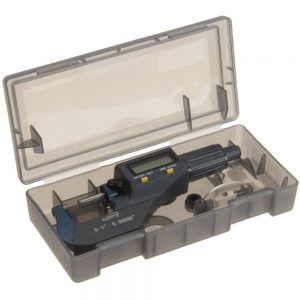

Verdict
The simplicity of the display and button layout are a nice touch and will be appreciated by those not as familiar with digital micrometers. The addition of the SPC output and ball attachment put these mics a step above most other entry level digital micrometers. To get a better micrometer you will need to pay 3 times the cost of these mics or more. The iGaging 0-1” digital micrometer is a solid budget priced inspection tool.
For more information on micrometers see these related articles:
